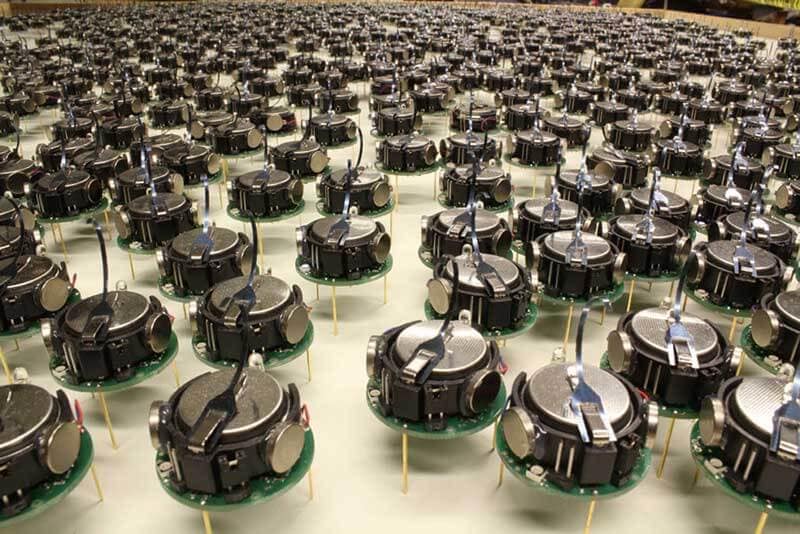- Inspired by nature: ants leading the way
- Military applications of swarm robotics technology
- Taking the research from a virtual into the real world
- Swarms of nanorobots could help us beat cancer
- When will swarm robotics be deployed to solve real world problems?
The relatively new field of swarm robotics emerged in the beginning of the 2000s. The concept is based on controlling vast numbers of minuscule robots simultaneously, with the objective of carrying out a task that would be too complex for a single machine to accomplish. A small robot in a swarm is made from ultra-light materials, compact sensors and wireless technology. The first of these little machines were experimental and compared to their size today, quite bulky and unable to carry out complex tasks. They were usually the size of small birds, also capable of flight but they had rather poor battery life and were made of heavy materials.
The technological advancements in the 2010s enabled us to develop a new generation of spy drones which could be as small as insects. And they didn’t just emulate the size of the insects, but also their body structure, behaviour and movements. And as electronic components keep getting smaller and we further develop technologies like artificial intelligence and remote guidance, we will be able to better organise these machines into bigger and more capable networks, capable of a large variety of tasks.
1. Inspired by nature: ants leading the way
Swarm behaviour can be seen in honeybees, wasps and ants. Engineers look to these insects as incredible examples of engineering to inspire them and guide them on how to create robots that can act in the same way. The way bees collect nectar for instance, is actually an algorithm that can be replicated in swarm robotics. The cockroach is another insect engineers like to take inspiration from. These bugs can detect changes in air pressure, which enables them to dodge danger extremely fast. Inspired by the collective behaviour of ants when building complex structures, researchers at the Wyss Institute created mobile robots capable of performing tasks collectively, including moving large objects from one location to another or even building human-scale structures all on their own. Most robots today can only perform the one function they were designed for, but Wyss researchers wanted to change that. One particularly promising application of their technology is a group of 1024 Kilobots that can be programmed in such a way that the commands apply to all of the robots in the swarm simultaneously, regardless of their number. This means that they can actually collaborate with each other, for instance gather materials together. A swarm of Kilobots could be very useful for pollinating fields, putting up barriers around toxic chemical spills or stacking sandbags along the coastline in preparation for floods or hurricanes.The applications are endless.

2. Military applications of the swarm robotics technology
By 2030, we will be able to create machines smaller than 0.15 mm. This minuscule size would make them almost invisible to the naked eye and suitable for a wide variety of applications, the military being the first that comes to mind. The military is constantly looking for ways to improve their soldiers’ capabilities in the field but more importantly, they are trying to develop devices that will allow them to perform tasks without endangering the lives of their soldiers. Millions of these machines, which are essentially flying robots, could be programmed to join together and form vast networks. These could then be dropped in capsules by UAVs and released into the environment to perform tasks like advanced reconnaissance, coordination of cyber-attacks or even physical attacks on military bases, either by targeting enemy soldiers or disabling large vehicles. The latter would be achieved by arming the robots with specialised appendages, capable of chewing through electronics and other defensive equipment, which would leave the enemy vulnerable to physical attacks. These swarms could even be used to target underground bunkers by dissolving their reinforced armour or finding their way inside through cracks, air vents or keyholes.
Not everything about these robot swarms has to be sinister, however. They have many other potential applications and could play an important role in environmental matters. They could serve as artificial pollinators in areas affected by the collapse of the bee colonies. They could also be used to provide incredibly detailed monitoring of the atmosphere, water and land. Search and rescue missions, healthcare and construction are just some of the other areas where swarm robotics technology could prove very valuable.
3. Taking the research from a virtual into the real world
When it comes to swarm robotics research, the majority of it has been confined to virtual reality simulations. The problem with these simulations is that they don’t take real-world constraints into account. That is why it is important to experiment with swarm behaviour algorithms in more realistic conditions as well, which would produce more accurate data. However, if we were to perform these tests in the labs, which are usually limited in size, we would need these robots to be as small as possible, particularly as we would need thousands of them to properly test the algorithms. Furthermore, such large numbers also mean that we need to find a way to keep the manufacturing and maintenance costs low, which is why they would need to be made from cheap and commonly available materials and components. Another aspect to keep in mind is that the robot needs to have a modular design that would allow us to quickly exchange pieces of hardware to accommodate the requirements of different swarm algorithms, such as different types of sensors.
4. Affordable modular robots
In June 2016, a team of researchers at the University of Toronto’s Department of Mechanical Engineering developed mROBerTO, a modular robot that meets all of these demands. mROBerTO costs about $60 to produce and even though it’s not yet available in stores, the developers will provide both the software and hardware source files. mROBerTO is only 16x16mm in size and comes with a modular design that allows you to easily add or remove components. It can be used for a variety of projects that require miniature robots but it was primarily designed to provide swarm robotics researchers with affordable physical tools that can help them test their swarm behaviour algorithms. Each robot has a unique ID and is equipped with IR photoresistors and transmitters, which they can use to send and receive IR signals and to determine other robots’ distance and bearings. They also have Bluetooth Smart and ANT Wireless communication capabilities, which allows them to communicate with each other. Finally, there are two small motors on the back of the robots which are responsible for their movement.
5. Swarms of nanorobots could help us beat cancer
Another type of swarm robotics is nanotechnology, which is slowly finding more and more promising applications a host of industries, including medicine. Scientists from various universities recently announced that they were able to create nanorobots capable of navigating through the bloodstream and injecting drugs into cancer cells. This is a groundbreaking revelation in the ongoing battle against cancer, one that could help us finally defeat the terrible disease which has already taken so many lives. Conventional cancer treatment like chemotherapy can damage a patient’s healthy organs and tissues. Nanotechnology, however, makes it possible to target only the cancer cells, without affecting the surrounding tissue. Professor Sylvain Martel, one of Canada’s foremost researchers in medical nanorobotics and Director of the Polytechnique Montréal Nanorobotics Laboratory, leads teams from Polytechnique Montréal, McGill University and Université de Montréal in successfully testing this method on mice. So far, there have been no human trials.
6. Nanorobots armed with cancer-killing bacteria
The nanorobots in question are actually composed of a strain of Magnetococcus marinus bacteria, or MC-1. Each robot holds more than a 100 million of these bacteria, with magnetic iron-oxide nanocrystals contained in each cell. Each tumour contains hypoxic zones, cells with low oxygen levels, that usually don’t respond to radiotherapy and most other forms of cancer treatment. But nanobots inserted into the tumour can locate these areas and inject them with drugs directly. During the trials, the MC-1 nanocarriers were able to successfully reach the target areas in the mice where, thanks to the strong propelling force of the drug, more than half of the MC-1 bacteria were injected deep into the tumours’ hypoxic zones.
7. Revolutionary transportation method
Not only will this transportation method help increase the effectiveness of chemotherapy, it also helps us develop improved engineering ideas, novel methods of intervention and new vehicles for imaging, diagnostic and therapeutic agents. The possibilities of this technology are only limited by our imagination and until today we have only scratched the surface of what it can do. From search and rescue missions, military applications in the form of reconnaissance robots or those that can attack and disable human targets or vehicles and infiltrate underground bunkers, robots that perform environmental tasks such as pollination of fields or helping with natural disasters, all the way to cancer fighting nanorobots, the applications of swarm robotics are nearly endless and we can only look forward to the future and wait to see what else it brings.
8. When will swarm robotics be deployed to solve real world problems?
Swarm robotics has the potential to promote flexibility, robustness and scalability but is not yet ready to be used to solve real-world challenges. Much more research is required to overcome hardware shortcomings that limit the functionality of these robot systems. Behavioural control is another area of swarm robotics that needs to be researched and tested in order to discover ways in which human operators can interact with the swarm. Furthermore, it is important to provide compelling case studies to demonstrate their applications such as in farming or waste removal, to demonstrate ways in which swarm robotics can be more effective than other approaches.




